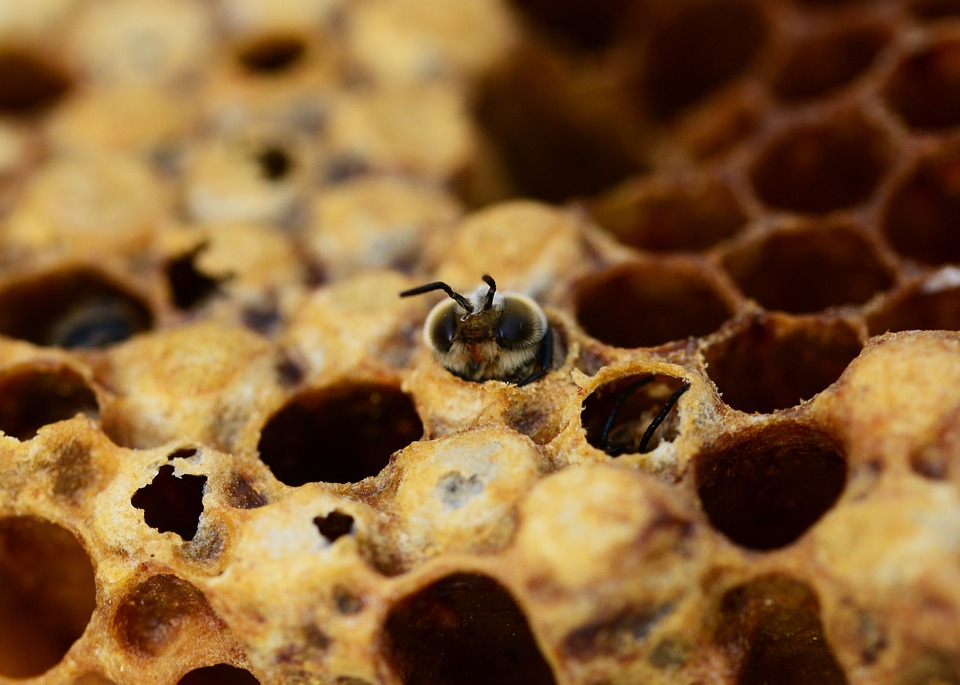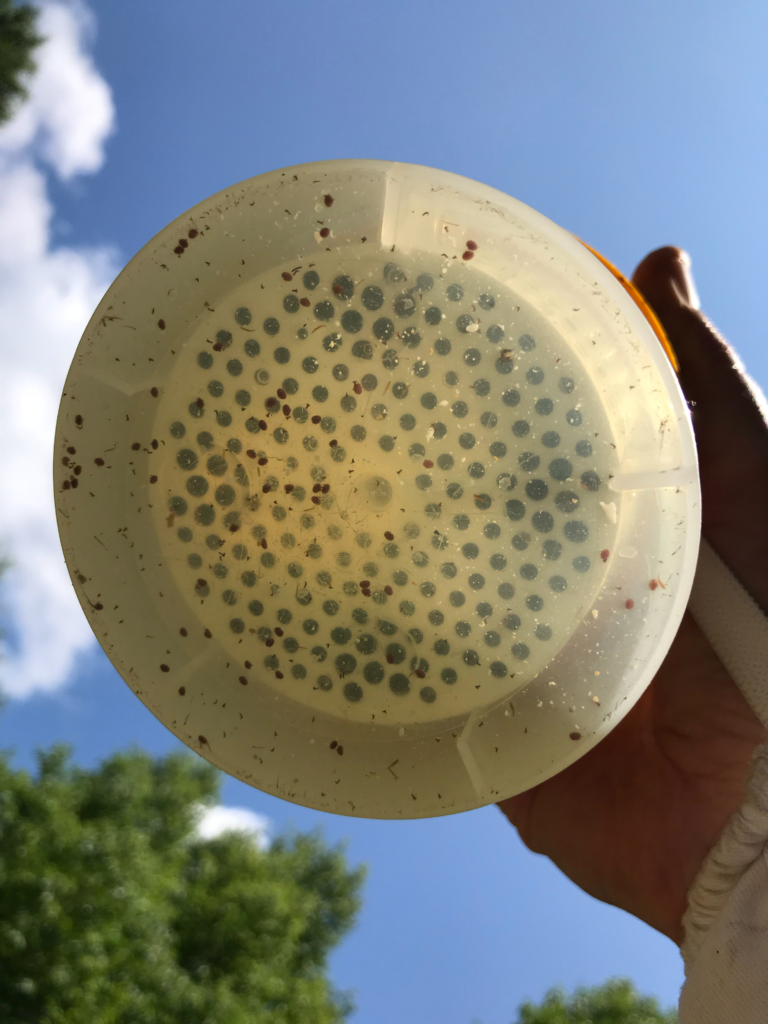Testing and treating your bees for Varroa destructor mites is imperative for hive survival.

Varroa mites are parasitic mites that attach to the abdomen of the honey bee and feed on the fat body (Figure 1). Sexually mature female Varroa mites reproduce by sneaking into brood cells before they are capped. Once enclosed in the brood cell, the Varroa mom will create a feeding site for her future offspring. Baby Varroa hatch within the capped cell and feed upon the fat of the defenseless brood. Fat body of the honey bee contains vitellogenin protein necessary for proper cellular functions of the developing bee. Loss of vitellogenin due to Varroa leaves young honeybees weakened upon hatching. Varroa typically carry viruses, and it’s likely the bee will emerge from their cell with the burden of infection as well. A male is the first of the offspring which will reproduce with its sisters. The longer the Varroa are capable of staying in the cell the more mites are able to mate in the brood cell and emerge as sexually mature females.

One mature female Varroa mite is capable of producing seven mites that may continue the reproductive cycle in new brood cells. The reproductive cycle of the mite is significantly faster than that of the honey bee. From the beginning of the spring to the end of the summer, Varroa population swells to the volume that can crash your bee hive before going into winter, therefore treatment is required right after honey harvest.
Bees can mildly mitigate Varroa concentrations by swarming, however such practice isn’t desirable for beekeepers. Brood breaks when queens halt egg production also provide a small period of time for Varroa populations to plataeu however these breaks are never long enough to prevent a total infestation when egg production resumes. In the northern climate, queen bees stop laying eggs in the winter. This slows the Varroa reproductive cycle. However, Varroa overwinter well and simply wait for the queen to re-start laying brood to begin laying their own. Honey bees simply cannot mitigate this vicious cycle.
Manual control for Varroa is a must!
Test for Varroa
Powder sugar roll

- Pick a frame of brood and shake the bees off into a bucket, then scoop 1/2 cup bees for your test (1/2 cup of nurse bees = approximately 300 bees). Place these bees in a clean jar with a #8 mesh hardware cloth fitted lid. One of the ends of the jar must have a coarse mesh screen so that the sugar and mites will fall through onto a plate and the bees will stay back.
- Add 1/2 powdered sugar to the jar. Let the bees sit in the powdered sugar for a minute prior to aggressively shaking the container for 1-whole minute. Release your bees back into the colony after this test. Count Varroa by misting water on top of dusted sugar. The misting allows better Varroa detection. Unfortunately, some mites will not let go off the bee during a powder sugar roll, and this method does not count all the mites but will give you a good item of Varroa levels in your hives.
Improve accuracy – Alcohol wash
A more accurate method is an alcohol wash (Figure 2). The technique is very similar, but the bees do not survive. Instead of powder sugar, any alcohol can be used for this purpose. This method is more commonly used in scientific studies to estimate Varroa levels because Varroa more easily dislodge from the honeybee host. Repetitive alcohol washes can be very hard on the bee population, especially in weak hives. Use your best judgement. Switch to powdered sugar roll in the fall if you plan on doing repetitive Varroa testing between treatments.

The threshold for Varroa is 3%, meaning you must treat if you find more than 3 mites/300 bees.
Treatment options
The most common Varroa management practices involve chemical treatments such as: thymol, oxalic acid vapor, formic acid, amitraz and coumaphos based Perizin. The latter two are very powerful neurotoxic insecticides that are losing efficacy as Varroa are able to build resistance to these compounds. These harsh chemicals also accumulate in the wax comb and hive products. The more natural chemicals like formic and oxalic acid disrupt the metabolism of the mite and therefore are less likely to develop resistance and also degrade faster in the environment. Exercise the highest levels of caution possible when using any chemicals in your hives. All options may halt brood production and can potentially kill the queen.
There are biological control solutions being developed at this very moment. Specific microbial and fungal metabolites are much safer to use. Biological control targets only Varroa, as oppose to broad spectrum destruction to control Varroa mites.
There are also special hygienic lineages of bees being bred that are capable of removing Varroa infested brood before viruses are compromise the health of the entire hive. Breeding bees to fight Varroa is not a new concept. Minnesota bee lab headed by Dr. Marla Spivak developed the first purposefully bred hygienic bees in 1994 when Varroa was becoming a serious issue. The commercial distribution of these bee genetics is gradually ramping up.
Doing nothing is not an option. By allowing the Varroa to proliferate, the contamination will spread to neighboring hives, and beyond. If left alone, Varroa will overcome honeybees. Help your bees by monitoring and treating for Varroa on a regular basis!
